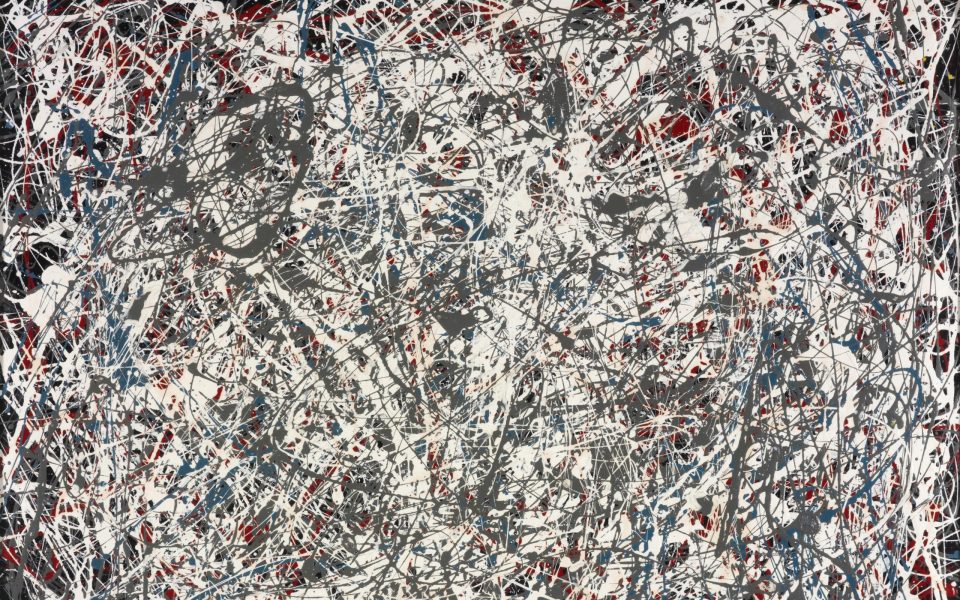Each
viewer sees a work of art through a lens of their own, whatever
distillation of events and ideas informs their unique experience of
the zeitgeist. It was the American modernists who gazed inward in
search of universal truths
that —
on the canvas —
could extrapolate meaning from the volatility and brutality of
so-called civilization.
Reynolda
House Museum of American Art is showing Hopper
to Pollock,
an exhibition of
American modernism
from the Munson-Williams-Proctor Arts Institute
in Utica, NY through May 12. Art collector Edward Wales Root
donated
the selection of iconic works to
the institute upon his death in 1956, and they reflect his support of
young artists working primarily in New York City, in contrast to most
other collectors of his generation, who sought treasures from Asia
and Europe. He was the son of Elihu Root, a high-powered
private-sector lawyer and Nobel Peace Prize laureate who advocated
for imperialist policies as a presidential cabinet member for both
William McKinley and Theodore Roosevelt.
Modernism
is a philosophical movement that arose across artistic disciplines in
the first half of the 20th
Century. In the realm of visual art, emerging artists like Jackson
Pollock, Charles Burchfield and Arthur B. Davies rejected realism in
favor of experimentation with form, especially through developing
techniques that highlighted materials and processes. Pollock is
considered the foremost exemplar of this aspect: In the late 1940s he
began to drip and fling —
reportedly with great control —
oil and enamel paints onto canvas or paper lying flat on his studio
floor. His “No. 20, 1948” hangs in a section of the gallery
focused on abstract expressionism.
“Artists
were experiencing these overwhelming changes — both positive and
negative — in the first half of the 20th
Century,” Reynolda House curator Allison Slaby says. “In addition
to industrial growth and scientific progress, artists were also
reacting to the horrors
of two world wars, an economic depression, the Holocaust, the nuclear
bomb. So they really did need to develop a new visual language to
respond to all of that, those disorienting effects of modernism, and
that’s how abstraction was born. Artists like Rothko and Pollock
were very articulate about why they began painting the way they did:
that they were accessing their psyches, they were looking to the
inner life of the mind rather than external artistic material.”
Rothko’s
1947 oil on linen “Number 11 (Untitled: Abstraction),” in which
of wisps of saffron punctuate muddy grays, beiges
and blues, hangs in the Mary and Charlie Babcock Wing Gallery at
Reynolda House. Radical avant-garde painters like Arthur Dove
alongside Rothko sought to evoke universal truths through
non-representational forms, rejecting known symbols for aesthetic
introspection. Others, like William Baziotes, continued to paint hazy
semblances mined from his psychological
landscape such as in “Toy,” a curious 1949 oil painting that
elicits childhood memories, prodding the subconscious to confront the
periwinkle iris of a long-necked creature.

The
installation’s three other sections focus on landscapes, still life
and figure studies, and a selection of American modernism from the
private collection of Barbara Babcock Millhouse, granddaughter of
tobacco-titans RJ and Katharine Reynolds, who founded the Reynolda
collection and directed acquisitions.
“It
really is about the perspective of one collector… Edward Wales
Root,” Slaby says. “But we at Reynolda have another story to
tell, and that’s the story of Barbara Babcock Millhouse. In some
ways, they were interested in some overlapping artists, so we thought
we had this great opportunity to display the Munson-Williams-Proctor
Arthur Dove but also Reynolda’s Arthur Dove … We wanted to focus
on … a different eye, looking at what Barbara was selecting
approximately 50 years after Edward Root was collecting.”
Hopper
to Pollock
is the first installation of Root’s collection to include
additional works from another private collection, each offering a
more well-rounded understanding of these collectors and of American
modernism.
Reynolda
curators wanted to include visitors in the exhibition’s emphasis on
the act of collecting art, beginning with an interactive grid of
goldenrod-colored papers hanging in the gallery entryway. As an
ensemble these glossy sheets spell out the
exhibition’s title, but when unhooked from the wall each reveals
the image and details about a specific piece from Hopper
to Pollock.
“The
viewer has a larger role in the art process with Modernism than ever
before,” Deputy Director Phil Archer says. “The viewer brings a
lot of the interpretation to the work; it can be very internal. Here,
you’re having your moment to claim and interact [with the artwork].
I think that’s one piece of the idea; I think the other piece is
this collecting notion. [In the gallery] you’re with one collector
then the Millhouse section is another collector. What preferences,
parts of [Root’s] mind and soul are reflected in what he chose?
Here, you get to choose one.”
When
asked about the potential for viewers to connect past to present, as
visitors re-examine cultural mores and reckon with their own
experiences of uncertain times, Slaby says, “One way to respond to
that idea is to be encouraged that new forms of art come out of times
of human toil and strife. The human response to rapid change is to
create something new, so that’s an encouraging way to think about
difficult periods of history.”
Join the First Amendment Society, a membership that goes directly to funding TCB‘s newsroom.
We believe that reporting can save the world.
The TCB First Amendment Society recognizes the vital role of a free, unfettered press with a bundling of local experiences designed to build community, and unique engagements with our newsroom that will help you understand, and shape, local journalism’s critical role in uplifting the people in our cities.
All revenue goes directly into the newsroom as reporters’ salaries and freelance commissions.


Leave a Reply